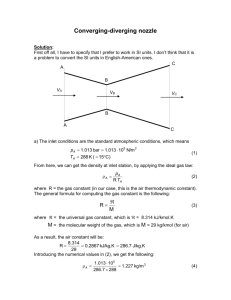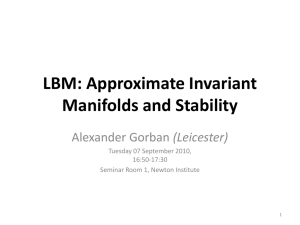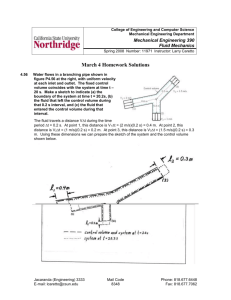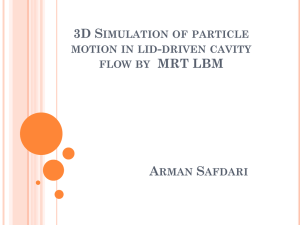supplemental material - Springer Static Content Server
advertisement
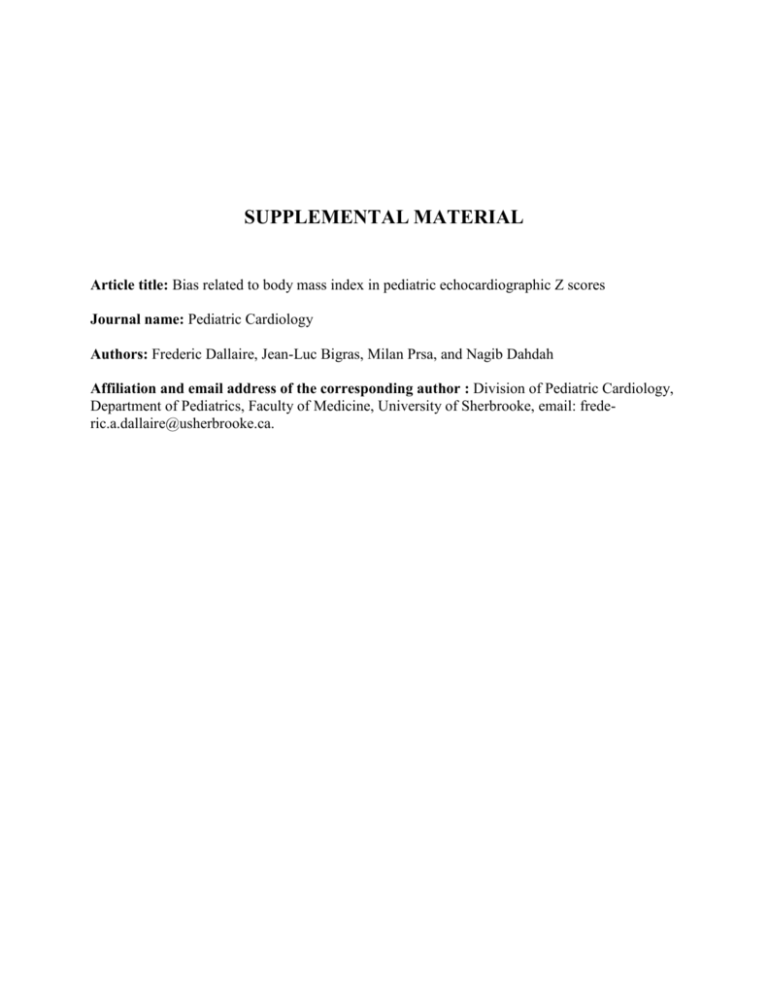
SUPPLEMENTAL MATERIAL Article title: Bias related to body mass index in pediatric echocardiographic Z scores Journal name: Pediatric Cardiology Authors: Frederic Dallaire, Jean-Luc Bigras, Milan Prsa, and Nagib Dahdah Affiliation and email address of the corresponding author : Division of Pediatric Cardiology, Department of Pediatrics, Faculty of Medicine, University of Sherbrooke, email: frederic.a.dallaire@usherbrooke.ca. 2 SUPPLEMENTAL METHODS Modelization of the mean - bivariate models Bivariate allometric models (y = axb) were first computed using four body size measurements: height, weight, BSA, and LBM. Allometric models were chosen based on the work by Sluysmans and Colan [1]. Other types of bivariate models were also explored to optimize the fit of the regressions. These included a linear model (y = ax + b), a gamma function model [y = axb exp(−cx)], a polynomial model with the square root of the dependent variable (y = ax + bx + c), and a regular polynomial model up to the third order (y = ax3 + bx2 + cx + d) [2-4]. Only subjects with a BMI within the 2nd and 98th percentiles were used to derive the new Z score equations. Modelization of residual values For each model described above, residual values (observed diameter minus the mean diameter predicted from the model) were calculated. Heteroscedasticity was present in most regression models: that is, the variance of the residual values increased with body size. To account for this, the slope of increasing standard deviation (SD) was calculated by computing a linear regression of the absolute value of the residual values against the independent variable used for normalization (height was used when more than one independent variable was present in the model). In preliminary analyses, more complex modelization of the SD of the residual values did not significantly improve goodness-of-fit. Residual values are assumed to be normally distributed (see below). Consequently, the absolute values of the residuals values will adopt a half-normal distribution. Since the mean of a half standard normal distribution is √(2/π), the predicted mean of the 3 absolute residuals multiplied by √(π/2) is an estimate of the SD of the residuals according to the independent variable [5]. Assessment of the validity of newly computed Z scores Z scores are used to evaluate if a dimension is within the limits (usually +/- two SDs from the mean) expected for a given individual. Because the aim is to obtain a Z score that is independent of body size, there should not be any residual association with the dependent variables used for the normalization. Furthermore, one should also ascertain that a strong association is not present with other body size measurements. To examine this, the Z scores of all the models were plotted against age, weight, height, and BSA to visually assess the absence of residual association and to appreciate the symmetry of the distribution of the residual values around the mean. Linear regression was also used to detect statistically significant slopes. Finally, because Z scores need to have a normal distribution in order to validly estimate percentiles, each Z score estimation was evaluated for departure from a normal distribution with a mean of 0 and a SD of 1 by visual assessment (normal probability plot) and by using the AndersonDarling test. This was done for all subjects, and for three subgroups corresponding to the lowest, middle and highest tertiles of the independent variable. Obvious outliers with significant influence on regression coefficients were deleted from the database and the Z scores were recomputed. SUPPLEMENTAL TABLES Table 3: Z score equations for ascending aortic diameter according to the independent variables used for normalization. Description Equation for the predicted mean Equation for the standard deviation Polynomial models with square root transformation (males) Weight AscAomean = (−0,220 × wt) + (4.906 × √wt) + (−0.347) AscAoSD = 0.0161 × wt + 1.303 Height AscAomean = (−8.364 × ht 2 ) + (69.469 × ht) + (−78.841 × √ht) + 33.221 AscAoSD = 0.830 × ht + 0.731 LBM AscAomean = (−0.00221 × LBM 2 ) + (0.0205 × LBM) + (3.747 × √LBM) + 3.300 AscAoSD = 0.0219 × LBM + 1.263 BSA AoVmean = (−4.591 × BSA) + (27.966 × √BSA) + (−4.033) AscAoSD = 0.716 × BSA + 1.057 Polynomial models with square root transformation (females) Weight AscAomean = (−0.142 × wt) + (3.986 × √wt) + 1.705 AscAoSD = 0.0207 × wt + 0.996 Height AscAomean = (12.588 × ht 2 ) + (−59.142 × ht) + (89.827 × √ht) + (−28.118) AscAoSD = 1.030 × ht + 0.302 LBM AscAomean = (−0.0000158 × LBM 2 ) + (−0.0861 × LBM) + (3.718 × √LBM) + 4.0436 AscAoSD = 0.0269 × LBM + 0.999 BSA AscAomean = (−0.0593 × BSA) + (18.933 × √BSA) + (−0.133) AscAoSD = 0.958 × BSA + 0.354 Males AscAomean = (−10.202 × ht 2 ) + (74.192 × ht) + (−86.798 × √ht) + (0.717 × √wt) + 35.442 AscAoSD = 0.836 × ht + 0.707 Females AscAomean = (9.160 × ht 2 ) + (−44.664 × ht) + (69.321 × √ht) + (0.653 × √wt) + (−21.262) AscAoSD = 0.949 × ht + 4.170 Multivariable stepwise model AscAo = ascending aortic diameter, BSA = body surface area, ht = height; LBM = lean body mass, wt = weight. 5 Table 4: Z score equations for Sinus of Valsalva diameter according to the independent variables used for normalization. Description Equation for the predicted mean Equation for the standard deviation Polynomial models with square root transformation (males) Weight SoVmean = (−0.239 × wt) + (5.439 × √wt) + 0.00511 SoVSD = 0.0249 × wt + 1.232 Height SoVmean = (4.906 × ht 2 ) + (−20.711 × ht) + (49.276 × √ht) + (−15.549) SoVSD = 1.133 × ht + 0.540 LBM SoVmean = (0.00153 × LBM 2 ) + (−0.484 × LBM) + (6.988 × √LBM) + 0.0352 SoVSD = 0.0282 × LBM + 1.316 BSA SoVmean = (−5.390 × BSA) + (31.987 × √BSA) + (−4.597) SoVSD = 0.992 × BSA + 0.958 Polynomial models with square root transformation (females) Weight SoVmean = (−0.210 × wt) + (4.908 × √wt) + 0.987 SoVSD = 0.0289 × wt + 1.00104 Height SoVmean = (18.0511 × ht 2 ) + (−98.937 × ht) + (149.277 × √ht) + (−51.260) SoVSD = 1.288 × ht + 0.212 LBM SoVmean = (0.00285 × LBM 2 ) + (0.476 × LBM) + (6.205 × √LBM) + 1.748 SoVSD = 0.0414 × LBM + 0.984 BSA SoVmean = (−3.331 × BSA) + (26.751 × √BSA) + (−2.430) SoVSD = 1.197 × BSA + 0.646 SoVmean = (3.100 × ht 2 ) + (−15.734 × ht) + (40.991 × √ht) + (0.684 × √wt) + (−13.197) SoVSD = 1.141 × ht + 0.513 SoVmean = (14.478 × ht 2 ) + (−83.380 × ht) + (127.421 × √ht) + (0.637 × √wt) + (−43.906) SoVSD = 1.316 × ht + 0.172 Multivariable stepwise model Males Females BSA = body surface area, ht = height; LBM = lean body mass, wt = weight, SoV = Sinus of Valsalva diameter. SUPPLEMENTAL REFERENCES 1. Sluysmans T and Colan SD,(2005) Theoretical and empirical derivation of cardiovascular allometric relationships in children. J Appl Physiol 99(2): 445-457. 2. Dallaire F and Dahdah N,(2011) New Equations and a Critical Appraisal of Coronary Artery Z Scores in Healthy Children. J Am Soc Echocardiogr 24(1): 60-74. 3. Mawad W, Drolet C, Dahdah N, and Dallaire F,(2013) A Review and Critique of the Statistical Methods used to Generate Reference Values in Pediatric Echocardiography. J Am Soc Echocardiogr 26(1): 29-37. 4. Nevill AM, Bate S, and Holder RL,(2005) Modeling physiological and anthropometric variables known to vary with body size and other confounding variables. Am J Phys Anthropol Suppl 41: 141-153. 5. Altman DG,(1993) Construction of age-related reference centiles using absolute residuals. Stat Med 12(10): 917-924.


